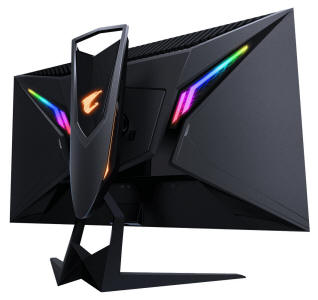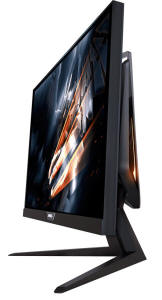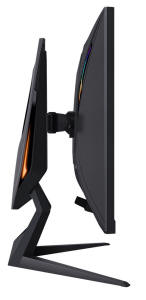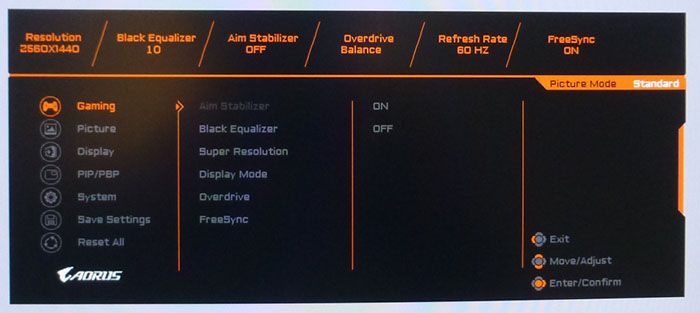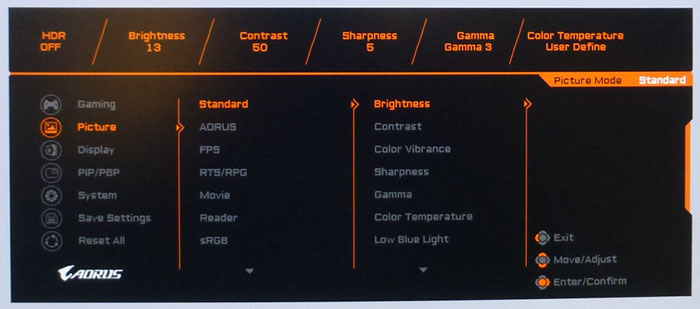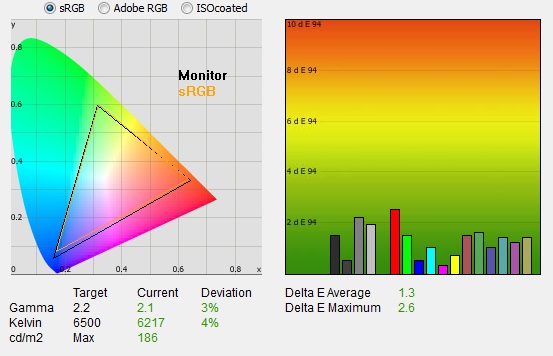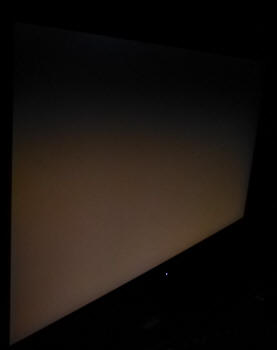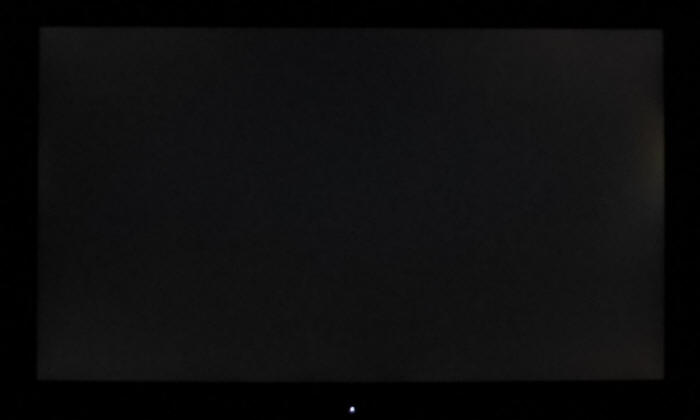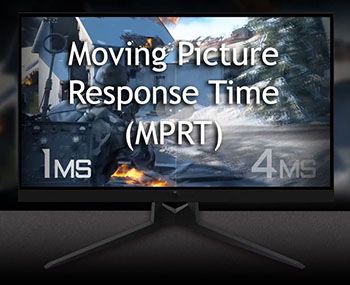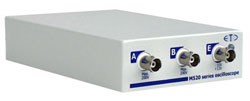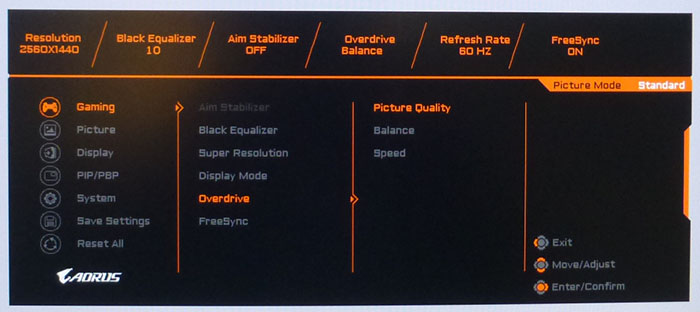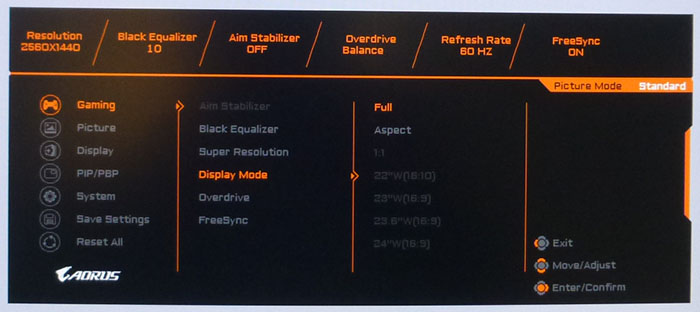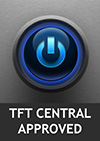|
|
||||
|
||||
|
|
|
|||||||||||||||||||||||||||||||||||||||||||||||||||||||||||||||||||||||||||||||||||||||||||||||||||||||||||||||||||||||||||||||||||||||||||||||||||||||||||||||||||||||||||||||||||||||||||||||||||||||||||||||||||||||||||||||||||||||||||||||||||||||||||||||||||||||||||||||||||||||||||||||||||||||||||||||||||||||||||||||||||||||||||||||||||||||||||||||||||||||||||||||||||||||||||||||||||||||||||||||||||||||||||||||||||||||||||||||||||||||||||||||||||||||||||||||||||||||||||||||||||||||||||||||||||||||||||||||||||||||||||||||||||||||||||||||||||||||||||||||||||||||||||||||||||||||||||||||||||||||||||
|
Monitor Specifications |
|||
|
Size |
27" |
Panel Coating |
Light AG coating |
|
Aspect Ratio |
16:9 flat |
Interfaces |
1x DisplayPort 1.2a 2x HDMI 2.0
1x headphone jack |
|
Resolution |
2560 x 1440 |
||
|
Pixel Pitch |
0.233mm |
Design colour |
Matte black bezels with black aluminium stand and base |
|
Response Time |
1ms MPRT ('Aim Stabilizer'
On) |
Ergonomics |
Tilt, 130mm height, swivel, rotate |
|
Static Contrast Ratio |
1000:1 |
||
|
Dynamic Contrast Ratio |
12 million:1 |
VESA Compatible |
Yes 100 x 100 mm |
|
Brightness |
350 cd/m2 |
Accessories |
DisplayPort, HDMI, power, USB cables |
|
Viewing Angles |
178 / 178 |
||
|
Panel Technology |
Innolux AAS (IPS-type) |
Weight |
with stand: 8.0 Kg |
|
Backlight Technology |
W-LED |
Physical Dimensions (WxHxD) |
614.9 x 484.7 x 236.9 mm |
|
Colour Depth |
1.07b (8-bit+FRC) |
||
|
Refresh Rate |
144Hz |
Special Features |
AMD FreeSync, Certified 'G-sync Compatible' by NVIDIA, RGB LED lighting system, headphone and mic jacks, 2x USB 3.0 |
|
Colour Gamut |
Wide gamut 95% DCI-P3 |
||
The Aorus AD27QD offers a good range of modern connectivity with 1x DisplayPort 1.2a and 2 x HDMI 2.0 offered for video connections. For PC connectivity the DisplayPort is the most common option, with HDMI being available then for connecting external games consoles or Blu-ray players potentially. Both will support variable refresh rates from AMD graphics cards or games consoles. From NVIDIA cards you can only use VRR over DisplayPort.
The screen has an internal power supply and comes packaged with the power cable you need. A headphone output connection and mic input are provided as well for audio pass-through, but there are no integrated stereo speakers on this model. There are also a couple of USB ports located on the back of the screen.
Below is a summary of the features and connections of the screen.
|
Feature |
Yes / No |
Feature |
Yes / No |
|
Tilt adjust |
|
DVI |
|
|
Height adjust |
|
HDMI |
|
|
Swivel adjust |
|
D-sub |
|
|
Rotate adjust |
|
DisplayPort |
|
|
VESA compliant |
|
Component |
|
|
USB 2.0 Ports |
|
Audio connection |
|
|
USB 3.0 Ports |
|
HDCP Support |
|
|
Card Reader |
|
Integrated Speakers |
|
|
Ambient Light Sensor |
|
PiP / PbP |
|
|
Human Motion Sensor |
|
Blur Reduction Mode |
|
|
Touch Screen |
|
NVIDIA G-Sync (native) |
|
|
Factory calibration |
|
AMD FreeSync |
|
|
Hardware calibration |
|
G-sync Compatible Certified |
|
|
Uniformity correction |
|
Meaningful HDR |
|


Design and
Ergonomics
The Aorus AD27QD comes in a black design with matte plastics used for the bezel and rear enclosure. There is 3 side borderless design with a very thin 2mm plastic trim around the sides and top. There is also a further 6.5mm black panel edge, giving a total border of 8.5mm along the sides and top. The bottom bezel is thicker at 23mm, with an additional 4mm black panel edge (27mm in total). There is a shiny silver 'Aorus' logo in the middle of the bottom bezel and a small power LED beneath that.
The stand is made of black aluminium and provides a sturdy and quite heavy base for the screen. It connects quickly and easily via a clip mechanism but can also be removed for VESA 100mm mounting if you want. It's quite a deep stand (236.9mm total screen depth), so you will need to make sure your desk is deep enough to accommodate it at a comfortable viewing distance.
The back of the screen is encased in matte black plastics with a fairly busy design. The RGB lighting system is situated within two "wing" areas on the back, with additional strips along the side of the stand and the logo on the back of the stand. This can be customised using the provided software or via the OSD menu. It might have been nice to provide some downwards lighting as well, as not everyone is going to have the screen in a position where you can even see the back. There is a useful carry handle on the top of the stand as well for transporting it around although this does sometimes stick out a bit above the top of the screen if you have it positioned at lower heights. Not everyone is going to like the design of the stand, but that's down to individual preference.
There is a fairly deep profile to the screen as you can see above because of the stand. The stand does offer a very good range of ergonomic adjustments though. Tilt provides a wide adjustment range but is stiff to operate. Height adjustment is easier to move and smooth to operate. At the lowest height adjustment the bottom edge of the screen is about 70mm from the desk, and at maximum extension about 195mm. This provides a 125mm total height adjustment range, just shy of the advertised 130mm. Side to side pivot is smooth and easy to use. Even the rotation function is pretty easy to adjust, although sometimes a little fiddly to get it back level again. The screen remains very stable when adjusted and in normal use, with the stand providing a sturdy base for the screen.

A summary of the ergonomic adjustments are shown below:
|
Function |
Range |
Smoothness |
Ease of Use |
|
Tilt |
Yes |
Smooth |
Stiff |
|
Height |
125mm |
Smooth |
Easy |
|
Swivel |
Yes |
Smooth |
Easy |
|
Rotate |
Yes |
Smooth |
Pretty easy |
|
Overall |
Good adjustments offered and mostly easy to use. Tilt could be a bit less stiff. Sturdy with no wobble. |
||
The materials were of a good standard and the build quality felt solid. There was no audible noise from the screen, even when conducting specific tests which can often identify buzzing issues. The whole screen remained pretty cool even during prolonged use.
The back of the screen features the connections as shown above. Useful to see mic input, headphone output and 2x USB 3.0 ports provided. It might have been nice to have a couple of extra USB ports for easy access on the side of the screen perhaps.

The OSD is controlled through a single joystick on the bottom edge of the screen. There is quick access to the preset modes, volume control, black equalizer and input selection although this can also be customised in the main menu.
The main OSD menu provides a massive range of options to play with and tweak, really comprehensive. Navigation was quick, easy and pretty intuitive with the joystick, and you can also use the OSD Sidekick software we will look at in a moment if you'd rather. We won't go through all the options as there's too many to cover but a couple of examples are shown above.

OSD
Sidekick Software

Gigabyte offer a pretty useful piece of software for free from their website which can be used to control all the screen settings. This avoids you needing to use the OSD control joystick, although to be fair that's very useable anyway. We will provide a brief look at the software here for reference since we installed it to check the latest firmware of the screen was installed. We found ourselves using this throughout our testing too as it was quick and easy to change settings using it.
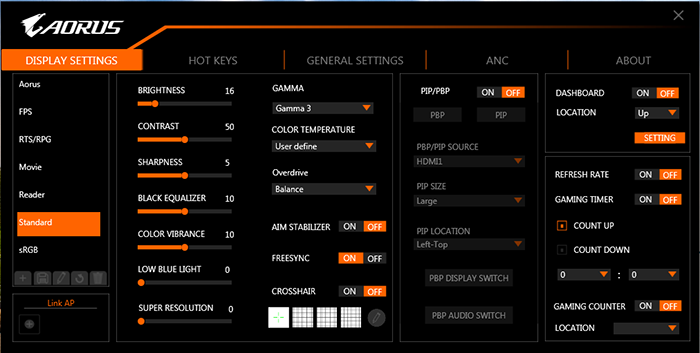
The main section allows you to quickly and easily switch between the preset modes, and change all the main OSD controls. You can also save new profiles and import settings which is pretty cool.
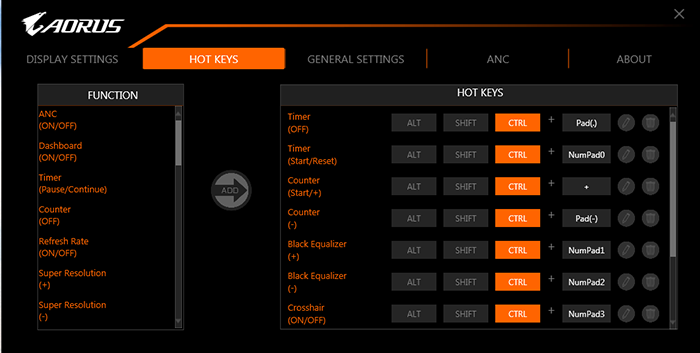
You can set up hotkeys to trigger different functions as well which can be useful when in a game or if you want quick access to certain things.
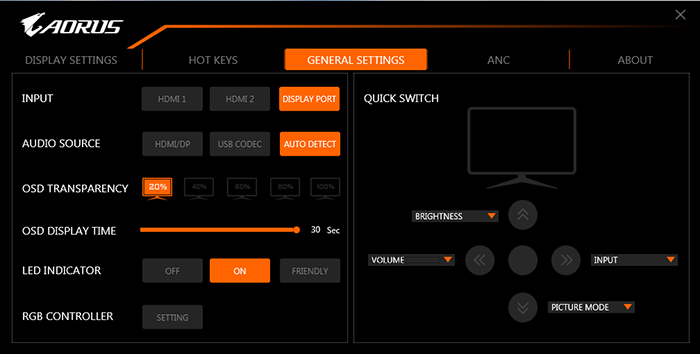
You can control some other settings here, including change the quick launch controls for the OSD control joystick, and also the RGB lighting system.
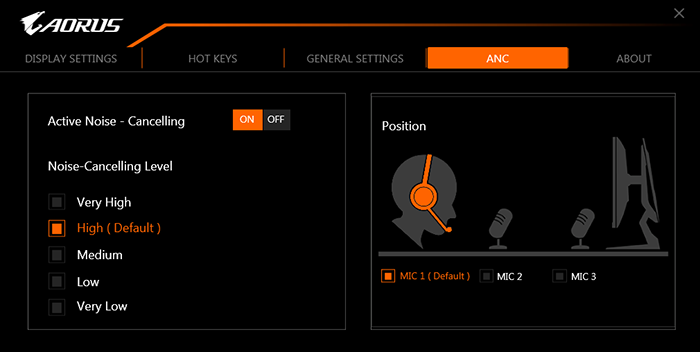
This section allows you to control the Active Noise Cancelling technology if you need to.
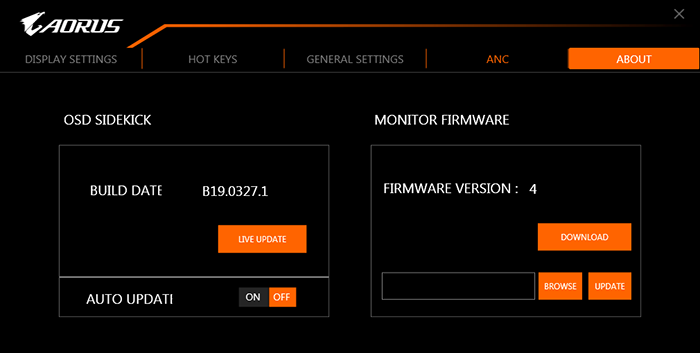
The final section allows you to update the monitor firmware which is downloadable form Gigabyte's website. There have been two versions available so far, oddly named as v2 and v4 (what happened to v1 and v3?). The v2 was the original firmware, but v4 brought a few improvements according to their website: "2nd released version. Update include: 1. Picture mode UX improvement. 2. Add Save settings function. 3. Text correction". This v4 was already installed on our test unit.

Power Consumption
|
|
|
We have plotted these results below compared with other screens we have tested. The consumption (comparing the calibrated states) is comparable to most of the similarly sized screens here as you might expect. It is less than the Asus ROG Swift PG27UQ, which while being the same 27" in size, has a Full Array Local Dimming (FALD) backlight for HDR and so uses a lot more power. Larger 32 - 34" screens also dray more power due to their size.


Panel and Backlighting
|
|
Panel Part and Colour Depth
The Gigabyte Aorus AD27QD features an Innolux M270KCJ-K7B AAS (IPS-type) technology panel. This is Innolux's "Azimuthal Anchoring Switch" technology, their equivalent to In Plane Switching (IPS) and it is the first time we've tested a screen using this new panel option for high refresh rate gaming. All the 27" 1440p IPS-type screens produced to date have featured panels from AU Optronics, like the Acer Predator XB270HU / XB271HU, Asus ROG Swift PG279Q and the recently tested Nixeus NX-EDG27S v2 for instance. So this is a new panel alternative from Innolux which is starting to be used in a few screens including this Gigabyte model, and also the recently released Acer Nitro XV272U.
The panel offers 1.07 billion colours using an 8-bit + FRC colour depth. Some people may complain that the panel is not a native full 10-bit panel, but in reality you are going to be very hard pressed to see any real difference in practice between a good 8-bit+FRC panel and a true 10-bit panel. Even more so when you consider whether you're going to actually be able to use the 10-bit colour depth in real use. Whether or not you can make use of this 10-bit colour depth depends on your graphics card and applications although many consumer gaming graphics card will be able to use it for modern games and HDR. You would need a high end professional grade graphics card to make use of 10-bit in pro applications like Photoshop though.
Screen
Coating
The screen coating is a light anti-glare (AG) offering. It isn't a semi-glossy coating, but it is light as seen on other modern IPS type panels. Thankfully it isn't a heavily grainy coating like some much older IPS panels feature and is also lighter than modern TN Film panel coating. It retains its anti-glare properties to avoid too many unwanted reflections of a full glossy coating, but does not produce too grainy or dirty an image that some thicker AG coatings can.
Backlight Type and Colour Gamut
The screen uses a White-LED (W-LED) backlight unit which is standard in today's market. This helps reduce power consumption compared with older CCFL backlight units and brings about some environmental benefits as well. The W-LED unit here offers a wide colour gamut which gives a 95% DCi-P3 coverage. This is equal to around 129% of the sRGB colour space according to our measurements. If you want to read more about colour spaces and gamut then please have a read of our detailed article.
Backlight
Dimming and Flicker
We tested the screen to establish the methods used to control backlight dimming. Our in depth article talks in more details about a previously very common method used for this which is called Pulse Width Modulation (PWM). PWM involves the rapid switching of the backlight off/on to simulate lower brightness levels when you adjust the screen's brightness control. This in itself gives cause for concern to some users who have experienced eye strain, headaches and other symptoms as a result of the flickering backlight caused by this technology. We use a photosensor + oscilloscope system to measure backlight dimming control with a high level of accuracy and ease. These tests allow us to establish:
1) Whether PWM is being used to control the
backlight
2) The frequency and other characteristics at which this operates, if it is used
3) Whether a flicker may be introduced or potentially noticeable at certain
settings
If PWM is used for backlight dimming, the higher the frequency, the less likely you are to see artefacts and flicker. The duty cycle (the time for which the backlight is on) is also important and the shorter the duty cycle, the more potential there is that you may see flicker. The other factor which can influence flicker is the amplitude of the PWM, measuring the difference in brightness output between the 'on' and 'off' states. Please remember that not every user would notice a flicker from a backlight using PWM, but it is something to be wary of. It is also a hard thing to quantify as it is very subjective when talking about whether a user may or may not experience the side effects.
The Tests for this display are shown below.
100%
50%
0%



Above scale
= 1 horizontal grid = 5ms
At all brightness settings a constant Direct Current (DC) voltage is applied to the backlight, and the screen is free from the obvious off/on switching of any PWM dimming method. As a result, the screen is flicker free as advertised.
|
Pulse Width Modulation Used |
No |
|
Cycling Frequency |
n/a |
|
Possible Flicker at |
|
|
100% Brightness |
No |
|
50% Brightness |
No |
|
0% Brightness |
No |

Brightness
and Contrast
This section tests the full range of luminance (the brightness of the screen) possible from the backlight, while changing the monitors brightness setting in the OSD menu. This allows us to measure the maximum and minimum adjustment ranges, as well as identify the recommended setting to reach a target of 120 cd/m2 for comfortable day to day use in normal lighting conditions. Some users have specific requirements for a very bright display, while others like a much darker display for night time viewing or in low ambient light conditions. At each brightness level we also measure the contrast ratio produced by the screen when comparing a small white sample vs. a black sample (not unrealistic full screen white vs. full screen black tests). The contrast ratio should remain stable across the adjustment range so we also check that.
Graphics card settings were left at default with no ICC profile or calibration active. Tests were made using an X-rite i1 Display Pro colorimeter. It should be noted that we used the BasICColor calibration software here to record these measurements, and so luminance at default settings may vary a little from the LaCie Blue Eye Pro report you will see in other sections of the review.
|
OSD Brightness |
Luminance |
Black Point (cd/m2) |
Contrast Ratio |
|
100 |
471.44 |
0.40 |
1179 |
|
90 |
433.50 |
0.37 |
1172 |
|
80 |
395.41 |
0.34 |
1163 |
|
70 |
356.68 |
0.30 |
1189 |
|
60 |
317.28 |
0.27 |
1175 |
|
50 |
280.00 |
0.24 |
1167 |
|
40 |
241.02 |
0.21 |
1148 |
|
30 |
198.89 |
0.17 |
1170 |
|
20 |
154.72 |
0.13 |
1190 |
|
10 |
109.24 |
0.09 |
1214 |
|
0 |
62.92 |
0.05 |
1258 |
|
Total Luminance Adjustment Range (cd/m2) |
408.52 |
Brightness OSD setting controls backlight? |
|
|
Total Black Point Adjustment Range (cd/m2) |
0.35 |
||
|
Average Static Contrast Ratio |
1184:1 |
PWM Free? |
|
|
Recommended OSD setting for 120 cd/m2 |
13 |
At the full brightness setting in the OSD the maximum luminance reached a very high 471 cd/m2 which was a lot higher than the specified maximum brightness of 350 cd/m2 from the manufacturer in fact. There was a good 409 cd/m2 adjustment range in total, so at the minimum setting you could reach down to a pretty low luminance of 63 cd/m2. This should be low enough for most people including those wanting to work in darkened room conditions with low ambient light. A setting of 13 in the OSD menu should return you a luminance of around 120 cd/m2 at default settings. It should be noted that the brightness regulation is controlled without the need for Pulse Width Modulation for all brightness settings so the screen is flicker free.


We have plotted the luminance trend on the graph above. The screen behaves as it should in this regard, with a reduction in the luminance output of the screen controlled by the reduction in the OSD brightness setting. This is a linear relationship.
The average contrast ratio of the screen was measured at an impressive (for an IPS-type panel) 1184:1 which was very good. This was a fair bit higher than the specified 1000:1 which was good news.

Testing
Methodology
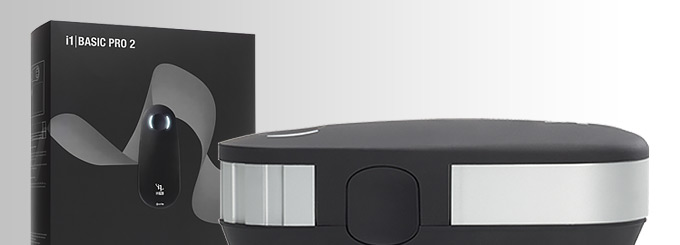
An important thing to consider for most users is how a screen will perform out of the box and with some basic manual adjustments. Since most users won't have access to hardware colorimeter tools, it is important to understand how the screen is going to perform in terms of colour accuracy for the average user.
We restored our graphics card to default settings and disabled any previously active ICC profiles and gamma corrections. The screen was tested at default factory settings using our new X-rite i1 Pro 2 Spectrophotometer combined with LaCie's Blue Eye Pro software suite. An X-rite i1 Display Pro colorimeter was also used to verify the black point and contrast ratio since the i1 Pro 2 spectrophotometer is less reliable at the darker end.
Targets for these tests are as follows:
-
CIE Diagram - confirms the colour space covered by the monitors backlighting in a 2D view, with the black triangle representing the displays gamut, and other reference colour spaces shown for comparison. Usually shown as a comparison against the common sRGB space
-
Colour space coverage volumes - we also measure using a piece of software called ChromaPure the colour space (gamut) volumes produced by the backlight in comparison to the sRGB, DCI-P3 and Rec.2020 colour spaces. sRGB is the most commonly used colour space so it is important to have a decent coverage from the screen here. If the colour space is >100% sRGB then the screen can produce a wider colour gamut, often reaching further in to the wider gamut DCI-P3 (commonly used for HDR) and Rec.2020 reference spaces.
-
Gamma - we aim for 2.2 which is the default for computer monitors
-
Colour temperature / white point - we aim for 6500k which is the temperature of daylight
-
Luminance - we aim for 120 cd/m2, which is the recommended luminance for LCD monitors in normal lighting conditions
-
Black depth - we aim for as low as possible to maximise shadow detail and to offer us the best contrast ratio
-
Contrast ratio (static) - we aim for as high as possible. Any dynamic contrast ratio controls are turned off here if present
-
dE average / maximum - we aim for as low as possible. If DeltaE >3, the color displayed is significantly different from the theoretical one, meaning that the difference will be perceptible to the viewer. If DeltaE <2, LaCie considers the calibration a success; there remains a slight difference, but it is barely undetectable. If DeltaE < 1, the color fidelity is excellent.

Default Performance
and Setup
Default settings of the screen were as follows:
|
Gigabyte Aorus AD27QD
|
|
|||||||||||||||||||||||||||||
|
|
Initially out of the box the screen was set with the 'Standard' preset mode. The display was set with a very high 80% brightness which was too bright and uncomfortable to use for long periods. You will want to turn that down. The colours were vivid and bright and you could tell the screen was using a wide gamut backlight here. We went ahead and measured the default state with the i1 Pro 2. The CIE diagram on the left of the image confirms that the monitors colour gamut (black triangle) extends quite a long way beyond the sRGB colour space reference (orange triangle), particularly in green and red shades. That create deeper and more vivid red and green colours as you will see from most wider gamut displays like this. We measured using ChromaPure software a 129% sRGB gamut volume coverage which corresponds to 95% of the DCI-P3 reference (as advertised) and 69% of the Rec.2020 reference. This is wider than normal sRGB screens by a considerable way, which helps create more vivid and bright colours for gaming, multimedia and HDR content. Some users may be worried about oversaturation of colours when working with sRGB-designed content, or doing colour critical work outside of a colour managed workflow. Gigabyte have included an sRGB emulation mode as well which we will look at in a moment. The screen is primarily aimed at gaming and multimedia and we expect the wider colour gamut to be a positive for most people in those uses. Default gamma was recorded at 2.3 average with a small 4% overall deviance from the target which was not too bad. White point was measured at very close to the 6500k target, with only a small 1% deviance at 6437k. |
|
Luminance at the default 80% brightness level was recorded at a very bright 407 cd/m2 which is far too high for prolonged general use, you will need to turn that down. The black depth was 0.35 cd/m2 at this default brightness setting, giving us a very good (for an IPS-type panel) static contrast ratio of 1164:1 which was very pleasing. Colour accuracy measurements should be ignored here really as they are comparing the produced wider gamut display colours against an sRGB reference which will always lead to errors. There was no sign of any colour banding which was good news.
Gamma Setting Measurements
|
Gamma OSD setting |
Measured Gamma Average |
Deviance from 2.2 |
|
Off |
2.1 |
5% |
|
1 |
1.9 |
14% |
|
2 |
2.1 |
5% |
|
3 |
2.3 |
4% |
|
4 |
2.5 |
13% |
|
5 |
2.7 |
22% |
We tested each of the gamma modes in the OSD
menu as well, to calculate the average gamma as well as the deviance from our
desired 2.2 level. The results are shown in the table above. The optimal setting
to achieve a 2.2 gamma was the default mode 3.
Color Temp Setting Measurements
|
Colour Temp OSD setting |
White point measurement |
|
Cool |
9404k |
|
Normal |
6526k |
|
Warm |
4934k |
|
User Define |
6437k |
We also tested the colour temp modes in the OSD menu while at the default screen settings. The 'User' mode gives you direct control over the RGB channels which will be useful for calibration in a moment. You may also want to try our recommended OSD settings from the calibration section perhaps to see how those look.

sRGB Emulation Mode
The screen has a native wide gamut backlight
producing 95% of the DCI-P3 colour space, and extending to around 129% coverage
of the sRGB reference. For multimedia, games and HDR that might be desirable and
gives a nice boost in colour vividness and overall appearance. However, for
colour critical work, photo editing and for those who need to specifically work
with standard sRGB content it could create some issues and complications.
Gigabyte have providing an sRGB emulation mode though, which allows you to work
with a more restricted colour space if you need to. We tested the screen's
performance in that mode as well:
|
Gigabyte Aorus AD27QD |
|
|||||||||||||||||||||||||||||
|
When you switch to the sRGB preset mode you can see a change to the colours of the screen, particularly on reds and greens. Most of the OSD options become locked however which is somewhat restrictive. You no longer have access to any of the settings shown in grey in the table above, including brightness, contrast, gamma and colour temperature. You can't use the low blue light modes of black equalizer settings, and even the response time control is locked to the 'balance' setting. We measured the performance in this pretty restricted sRGB mode anyway.
The CIE diagram shows that the colour space produced by the monitor very closely matches now the sRGB gamut. With ChromaPure we measured now a 100.2% sRGB coverage which was excellent. The gamma remains pretty reliable at 2.1 average, with a minor 3% deviance. Colour temp had become slightly warmer at 6217k but was still within a small 4% deviance from our target. Colour accuracy figures could now be considered, and we had an average dE of 1.3 which was excellent, showing accurate colour rendering across the board. Contrast ratio also remained strong for an IPS-type panel at 1129:1. The only real issue with this mode was that the brightness control is locked at 26, producing a luminance which is a bit too high for our liking at 186 cd/m2. This is a bit too bright for some ambient light conditions although not too bad. It's a shame that you can't control more of the OSD settings in this sRGB mode, especially the brightness level. Perhaps this could be added in a future firmware update. We felt the sRGB mode was still largely useable, but would have liked more control over the brightness.

Calibration
We used the X-rite i1 Pro 2 Spectrophotometer combined with the LaCie Blue Eye Pro software package to achieve these results and reports. An X-rite i1 Display Pro colorimeter was used to validate the black depth and contrast ratios due to lower end limitations of the i1 Pro device.
|
Gigabyte Aorus AD27QD
|
|
|||||||||||||||||||||||||||||
|
We calibrated the screen in the standard preset mode with the full native gamut of the backlight, and within the mode which gave us full control over the OSD settings. These were adjusted as shown in the table above, as guided during the calibration process and measurements. These OSD changes allowed us to obtain an optimal hardware starting point and setup before software level changes would be made at the graphics card level. We left the LaCie software to calibrate to "max" brightness which would just retain the luminance of whatever brightness we'd set the screen to, and would not in any way try and alter the luminance at the graphics card level, which can reduce contrast ratio. These adjustments before profiling the screen would help preserve tonal values and limit banding issues. After this we let the software carry out the LUT adjustments and create an ICC profile.
Average gamma was measured now at 2.2 average (0% deviance), correcting the small 4% deviance we'd seen out of the box. The white point was measured at 6450k leaving still a minor 1% deviance that we'd seen before out of the box but pretty close. Luminance had been improved thanks to the adjustment to the brightness control and was now being measured at a far more comfortable 119 cd/m2. We measured a black depth of 0.10 cd/m2 and this produced a static contrast ratio of 1176:1. This maintained the strong default contrast ratio which was pleasing.
Colour accuracy of the resulting profile was excellent, with dE
average of 0.6 and maximum of 1.2. LaCie would consider colour fidelity to be
excellent.
Testing the screen with various colour
gradients showed smooth transitions with some minor gradation in darker
tones but no visible banding at all.
You can use our settings
and try our calibrated ICC profile if you wish, which are available in
our ICC profile database. Keep in mind that results will vary from one
screen to another and from one computer / graphics card to another.

Calibration
Performance Comparisons
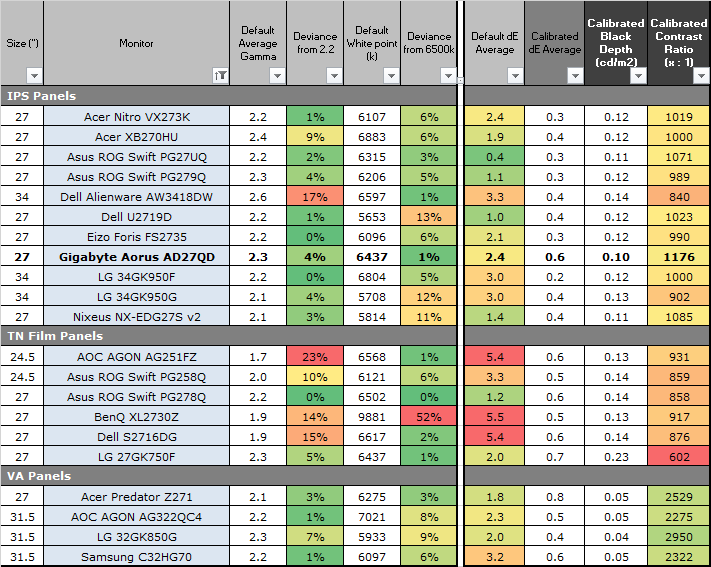
The comparisons made in this section try to give you a better view of how each screen performs, particularly out of the box which is what is going to matter to most consumers. We have divided the table up by panel technology as well to make it easier to compare similar models. When comparing the default factory settings for each monitor it is important to take into account several measurement areas - gamma, white point and colour accuracy. There's no point having a low dE colour accuracy figure if the gamma curve is way off for instance. A good factory calibration requires all 3 to be well set up. We have deliberately not included luminance in this comparison since this is normally far too high by default on every screen. However, that is very easily controlled through the brightness setting (on most screens) and should not impact the other areas being measured anyway. It is easy enough to obtain a suitable luminance for your working conditions and individual preferences, but a reliable factory setup in gamma, white point and colour accuracy is important and some (gamma especially) are not as easy to change accurately without a calibration tool.
From these comparisons we can also compare the calibrated colour accuracy, black depth and contrast ratio. After a calibration the gamma, white point and luminance should all be at their desired targets.
Default setup of the screen out of the box was good overall, offering a pretty accurate gamma curve, reliable white point and a strong static contrast ratio for an IPS-type panel. Remember that the screen operates with its full native 95% DCI-P3 colour gamut out of the box, giving a nice boost to colours for gaming and multimedia which are the primary uses of this monitor. There is an sRGB emulation mode available if you want to specifically work with the normal sRGB colour space, although it's a bit inflexible in terms of settings.
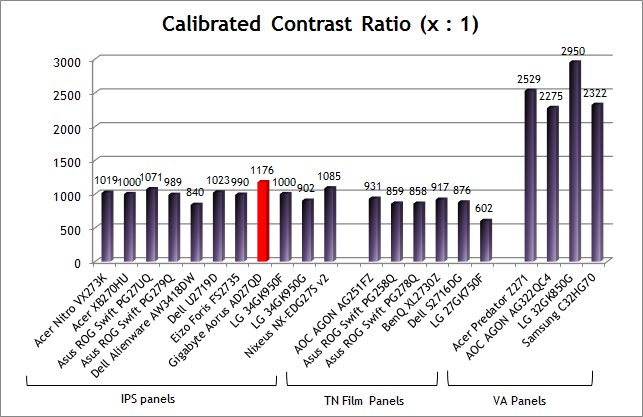
When it comes to black depth and contrast ratio the screen performed well for an IPS panel at 1176:1 after calibration. This was the highest of the models shown in the comparison table and graph above, and one of the highest we've seen to date from an IPS panel. We've seen a couple of models like the LG 34UC79G (1271:1) and Philips 328P6AUBREB (1287:1) reach a little higher, but this was a strong performance from this new Innolux IPS-type panel. It seemed to offer a contrast ratio a bit higher than popular 144Hz 27" IPS models like the Acer Predator XB270HU (1000:1) and Asus ROG Swift PG279Q (989:1).
it surpassed the TN Film models compared here which typically reached around 850:1. The VA panels can reach much higher though, up over 2000:1 easily as that's a strength of that panel technology.
|
Check Pricing and Buy - Affiliate Links |
|
TFTCentral is a participant in the Amazon Services LLC Associates Programme, an affiliate advertising programme designed to provide a means for sites to earn advertising fees by advertising and linking to Amazon.com, Amazon.co.uk, Amazon.de, Amazon.ca and other Amazon stores worldwide. We also participate in a similar scheme for Overclockers.co.uk. |

Viewing Angles

Above: Viewing angles shown from front and side, and from above and below.
Click for larger version
Viewing angles of the screen were very good as you would expect from an IPS-type panel. Horizontally there was very little colour tone shift until wide angles past about 45°. A slight darkening of the image occurred horizontally from wider angles as you can see above as the contrast shifted slighting. Contrast shifts were slightly more noticeable in the vertical field but overall they were very good. The screen offered the wide viewing angles of IPS technology and was free from the restrictive fields of view of TN Film panels, especially in the vertical plane. It was also free of the off-centre contrast shift you see from VA panels and a lot of the quite obvious gamma and colour tone shift you see from some of the modern VA panel type offerings.
Above: View
of an all black screen from the sides. Click for larger version
On a black image there is a fairly characteristic pale glow introduced to the image when viewed from a wide angle, commonly referred to as IPS glow. This type of glow is common on most modern IPS-type panels and can be distracting to some users. If you view dark content from a normal head-on viewing position, you may see this glow as your eyes look towards the edges of the screen. The level of glow was fairly typical overall for an IPS-type panel although a little more yellow and less white than some panels. In normal ambient lighting situations it was not too bad.

Panel Uniformity
We wanted to test here how uniform the brightness was across the screen, as well as identify any leakage from the backlight in dark lighting conditions. Measurements of the luminance were taken at 35 points across the panel on a pure white background. The measurements for luminance were taken using BasICColor's calibration software package, combined with an X-rite i1 Display Pro colorimeter with a central point on the screen calibrated to 120 cd/m2. The below uniformity diagram shows the difference, as a percentage, between the measurement recorded at each point on the screen, as compared with the central reference point.
It is worth noting that panel uniformity can vary from one screen to another, and can depend on manufacturing lines, screen transport and other local factors. This is only a guide of the uniformity of the sample screen we have for review.
![]()
Uniformity of Luminance
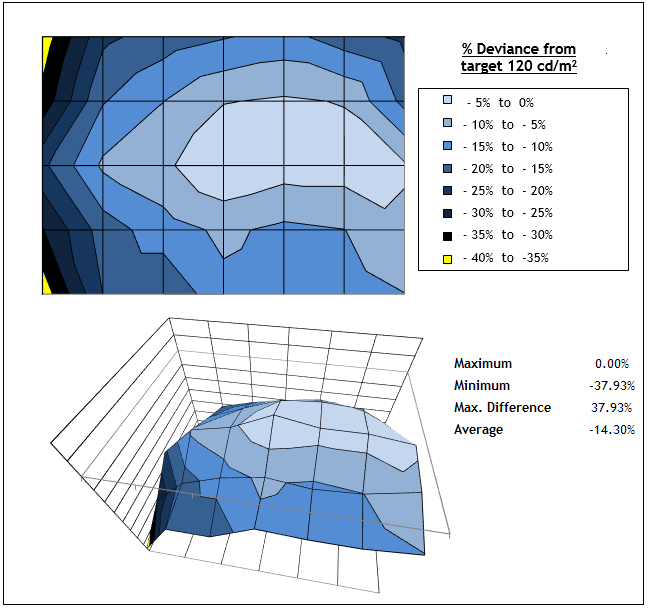
Luminance uniformity of the screen was not very good, with the left hand side of the screen showing the most deviance from our centrally calibrated point. In the corners the luminance dropped down to 87 cd/m2 in the most extreme example. Only 34% of the screen was within a 10% deviance of the centrally calibrated point which was an issue. For gaming and multimedia it's probably unlikely to cause you any problems day to day, but if you wanted to do any colour critical work or photo editing then the deviations could be cause for concern.
![]()
Backlight Leakage
Above: All
black screen in a darkened room. Click for larger version
We also tested the screen with an all black image and in a darkened room. A camera was used to capture the result. There was a little clouding evident in the bottom right hand corner, and a "pinched" area on the right hand edge you can see in the above image. Nothing you could spot in normal usage though.
Note: if you want to test your own screen for backlight bleed and uniformity problems at any point you need to ensure you have suitable testing conditions. Set the monitor to a sensible day to day brightness level, preferably as close to 120 cd/m2 as you can get it (our tests are once the screen is calibrated to this luminance). Don't just take a photo at the default brightness which is almost always far too high and not a realistic usage condition. You need to take the photo from about 1.5 - 2m back to avoid capturing viewing angle characteristics, especially on IPS-type panels where off-angle glow can come in to play easily. Photos should be taken in a darkened room at a shutter speed which captures what you see reliably and doesn't over-expose the image. A shutter speed of 1/8 second will probably be suitable for this.

General and Office Applications
This screen features a 2560 x 1440 WQHD resolution, a significant step up from the wide range of 1920 x 1080 screens on the market and a comfortable resolution for this size screen we feel. These higher resolution 27" models offer a tighter pixel pitch of 0.233mm which results in a smaller text size than common 24" 1080p screens, although it is still a nice and comfortable size. We are very used to working with 27" 1440p screens all the time and find them very comfortable and a significant upgrade over 1080 / 1200p models. Some users may find the small text a little too small to read comfortably, and we'd advise caution if you are coming from a smaller screen for instance where the pixel pitch and text are normally larger. The extra screen size takes some getting used to over a few days as there really is a lot of room to work with but once you do, it's excellent. For those wanting a high resolution for CAD, design, photo work etc, this is a really good option. The image was very sharp and crisp and text was very clear. With its WQHD display, you enjoy 77% more desktop space than a full HD screen to spread out your windows and palettes.
The screen does seem to show up in Windows as being able to support a 3840 x 2160 resolution which you can select if you want. The image shows fine but lacks the sharpness of a true 4K panel. It is definitely a 2560 x 1440 native resolution panel used here and we would recommend sticking with that as the resolution for all your applications. This "virtual 4K support" has been added to accommodate external inputs like games consoles where 4K is supported, but not 1440p. This avoids the need to select the lower 1080p resolution and have it scaled up, as you can instead select the 4K input and have it scaled down to hopefully help retain some detail.
The light AG coating of the IPS-type technology panel is certainly welcome, and much better than the older grainy and 'dirty' appearance of older IPS AG coatings. Although it's been several years since those more grainy coatings were used. The wide viewing angles provided by this panel technology on both horizontal and vertical planes, helps minimize on-screen colour shift when viewed from different angles. The default setup of the screen was good overall which was pleasing, especially considering this is a gaming display. By default the screen operates with a wide gamut offering 129% sRGB coverage. This is well suited to gaming, multimedia and HDR content producing brighter and more vivid colours. However, for more general and office work some people may need to work with the smaller, more common sRGB colour space. There is a decently set up sRGB mode available from the menu which emulates this smaller colour space very nicely, and will avoid any issues with oversaturation or off-colours outside of a colour managed workflow. It's a bit inflexible in terms of settings, being locked at a set brightness level for instance. We felt it was still pretty usable as thankfully the 186 cd/m2 fixed brightness was not too high for comfortable use. It would have been nice to offer more flexibility over this mode, or at the least provide adjustment to the brightness level. It's there though as an option if you specifically need to work with sRGB content and want to cut back on the wider native colour gamut.
The brightness range of the screen was very good, with the ability to offer a luminance between 471 and 63 cd/m2. This should mean the screen is useable in a wide variety of ambient light conditions, including darkened rooms. A setting of ~13 in the OSD brightness control should return you a luminance close to 120 cd/m2 out of the box. On another positive note, the brightness regulation is controlled without the need for Pulse Width Modulation (PWM), and so those who suffer from eye fatigue or headaches associated with flickering backlights need not worry.
There was no audible noise from the screen, even when conducting specific tests which can sometimes cause issues. There is a specific preset modes for office or text work from the "reader" mode, which makes the image a little warmer than our calibrated state. You can customise the settings in this mode, so it might well be useful for warmer or night time office work. There are also 10 settings for the low blue light mode to help filter out harmful blue light and make the image a little warmer in doing so.
There are 2x USB 3.0 ports which are useful. These are on the back of the screen with the video connections so are not really very easy access day to day. A couple of additional ports on the side of the screen for easy access would have been welcome. There are no other extras like ambient light sensors or card readers on this screen either. There is a full range of ergonomic adjustments which are mostly very smooth and easy to use. Tilt could have been a little less stiff but overall it's easy to get a comfortable position for different uses. There is also VESA 100mm mounting capabilities for those who want to arm or wall mount the screen instead.

Responsiveness and Gaming
|
Panel Manufacturer and Technology |
Innolux AAS (IPS-type) |
|
Panel Part |
M270KCJ-K7B |
|
Quoted G2G Response Time |
G2G spec not listed |
|
Quoted MPRT Response Time |
1ms MPRT (with 'Aim Stabilizer' On) |
|
Overdrive Used |
Yes |
|
Overdrive Control Available Via OSD Setting |
Overdrive |
|
Overdrive OSD Settings |
Quality, Balance, Speed |
|
Maximum Refresh Rate |
144Hz native |
|
Variable Refresh Rate technology |
AMD FreeSync |
|
Variable Refresh Rate Range |
48 - 144Hz (with LFC) |
|
Blur Reduction Backlight |
n/a |
An explanation of MPRT SpecsMoving Picture Response Time (MPRT) is all about articulating the level of perceived blur the user will experience from a given display. Traditional panel specs consider important things like the speed of the panel pixels (the G2G “response time”) and the frame “refresh rate” used. When considering MPRT specs, this also importantly accounts for eye movement and tracking of moving content on a sample-and-hold display technology like LCD. We talked about this in more detail in our article about blur reduction backlights but it’s important to understand how the human eye perceives motion blur on an LCD display. For a normal LCD display, without any special backlight technology added to specifically reduce perceived motion blur, the determining factor for MPRT is really the refresh rate. Pixel response times if they are particularly slow might add a small amount of additional time to a MPRT response time spec, but they are generally influenced almost entirely by the active refresh rate. On a 60Hz display the MPRT would be 16.67ms (i.e. the speed at which a new frame is sent to the screen being 1000ms / 60Hz = 16.67ms). On a 120Hz display this is halved to 8.33ms. On a 144Hz it would be 6.94ms, and on a 240Hz display it would be 4.16ms. That’s the current limit of available LCD screens right now, and so a 4.16ms MPRT is really the minimum that could be achieved without additional measures being taken. So where do these super-low “1ms MPRT” specs come from?… |
|
The common MPRT spec you will see used by display manufacturers today is 1ms, like that advertised for this Aorus AD27QD display. To achieve a 1ms MPRT spec an LCD based on current technology needs to feature some kind of blur reduction backlight to make it possible. This is used to remove the perceived image persistence and blurring you experience on a sample-and-hold display like this by strobing the backlight on and off. This makes tracking of moving objects much easier, producing clearer and sharper images with noticeably less blurring. You can read our full article for a lot more information and testing of these kind of backlights. Without a blur reduction backlight you would need 1000fps, at 1000Hz and with reliable 1ms pixel response times, to achieve a real 1ms MPRT on an LCD display, which is right now not possible of course.
As another note, just because a screen might use a blur reduction backlight, it doesn’t automatically mean that a 1ms MPRT would be realistic, as it will depend on various factors such as the strobe timing, strobe length, refresh rate etc. It should generally offer a better MPRT experience than a screen without a strobed backlight, but it’s not always truly 1ms. Although the spec seems to have crept in to modern display marketing as a generic catch-all for a screen which has a blur reduction backlight, regardless of whether that 1ms is actually fully achieved. The point here though is that where very low “MPRT” specs are quoted, that is normally an indication of a blur reduction backlight being available at least.
While a 1ms MPRT spec might be used so a manufacturer can advertise their screen to consumers with the “1ms” figure, it’s not always clear how the screen would perform with that feature disabled. For many situations, including when using VRR for G-sync/FreeSync, you can’t even use these blur reduction backlights. The performance without the strobing backlight in use needs to be considered carefully. More often than not the traditional “G2G” panel response time spec is probably more useful to understand, and at least gives you some kind of comparison to the way LCD screens are marketed the rest of the time. It’s very hard to consider how two screens compare when one has a blur reduction backlight and carries only a 1ms MPRT spec, and the other doesn’t offer that technology but instead has a 4ms G2G response time spec for example.
If MPRT specs are going to be included by manufacturers we would rather they also continue to provide the more traditional “G2G” response time spec as well to give a fairer comparison of the screen against other models which don’t feature blur reduction backlights. We know that those G2G response times figures are somewhat questionable in the real world anyway, but it’s better to provide some level of comparison between different screens without muddying the waters with an often meaningless MPRT spec.
As an example of why this spec is a problem on it’s own, you could have a very slow VA panel for instance that in normal use or VRR gaming offers a blurry experience and doesn’t perform well. If you added a strobing blur reduction backlight to it, maybe it could achieve a very fast, maybe even 1ms MPRT response time. On the other hand you could have a fast TN Film gaming screen without a blur reduction backlight that reliably achieves 2ms G2G response times, and therefore would be much better for normal gaming and VRR experience. Having a 1ms MPRT spec (or similar) just because a blur reduction backlight is used doesn’t tell the whole story at all.
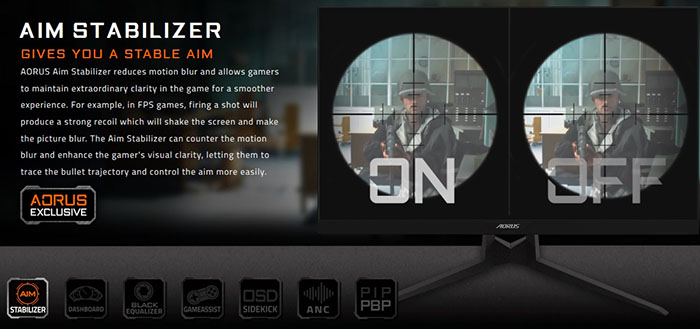
On the Aorus AD27QD a blur reduction backlight is available, but is really not obvious. In fact we missed it first time around as it's hidden oddly under the 'Aim Stabilizer' option in the OSD menu. It's talked about in fairly vague terms on the Gigabyte website as shown above. There's no mention in the Gigabyte website spec table about the 1ms MPRT applying in the 'Aim Stabilizer' setting either. We will test this blur reduction backlight in a moment.
When you look at the spec page the 1ms spec however is talked about as if it was achieved through improved pixel response times: "The AORUS AD27QD is one of the most responsive gaming monitors in the market. By accelerating the twisting speed of the liquid crystals, the response time can be reduced to 1ms, and let you enjoy a fluent gaming experience without any ghosting effects. This feature is particularly useful with high tempo games!". Are Gigabyte also implying the monitor has a 1ms G2G pixel response time here? That isn't listed in the spec anywhere, and there is no G2G figure quoted so it's a little hard for an average consumer to try and figure out how the screen might perform without the blur reduction backlight mode enabled. We would like to see manufacturers include a normal G2G figure if they are also going to include MPRT specs.

The screen uses overdrive technology to boost pixel transitions across grey to grey changes as with nearly all modern displays. The part being used is an Innoloux M270KCJ-K7B AAS (IPS-type) technology panel. Have a read about response time in our specs section if you need additional information about this measurement.
We use an
ETC M526
oscilloscope for these measurements along with a custom photosensor device.
Have a read of
our response time measurement article for a full explanation of the testing
methodology and reported data.

Overdrive Setting
|
We carried out some initial response time measurements and visual tests in each of the overdrive settings, and at a range of refresh rates. The response time control is available in the OSD menu via the 'Overdrive' option as shown above. These tests were conducted at a fixed refresh, with performance being basically the same whether FreeSync was turned on or off in the menu.
|
|
Overdrive = Quality



The overdrive 'quality' setting seems to basically be equivalent to an 'off' mode. We measured consistent response times across the range of refresh rates in this mode, averaging around 11.3ms G2G. Some transitions reached down to around 6ms in the best cases but there were a fair few which were slow up to 17 - 21ms. The rise times (changes from dark to light shades) were a bit slower than fall times (changes from light to dark shades). In motion tests we saw fairly high levels of blurring due to the pretty slow response times here. They were not really fast enough in this mode to keep up with refresh rates above around 80 -100Hz either, so you saw additional added blurring to the moving image at the higher refresh rate end. There was no overshoot at all in this mode at least but using one of the higher overdrive modes seems likely to deliver a better performance.
Overdrive = Balance



With the Overdrive turned up to the 'balance' setting we observed some fairly typical behaviour for a FreeSync screen. The response times seemed to actually increase a little as the refresh rate went up, which is counter-intuitive. You would expect response times to be boosted to faster speeds as refresh rate increased, but this is a common pattern we've seen on many FreeSync screens now. At 60Hz we measured a 9.1ms G2G average, with a little bit of overshoot starting to creep in. It was an improvement certainly compared with the 'quality' overdrive setting, speeding up some of the particularly slow rise times nicely now. In motion tests you could see an improvement in clarity and a reduction in blurring compared with the 'quality' setting.
As the refresh rate increased, the overdrive impulse seems to be turned down slightly, resulting in slightly slower response times - but the removal of any slight overshoot at least. At 100Hz we measured 9.6ms G2G average which was still on the whole fast enough to keep up with the frame rate here. At 144Hz the response times dropped slightly again, now measured at 10.2ms and not really being fast enough in many cases to keep up with the high 144Hz frame rate where <6.94ms response times are needed. This resulted in a little added blurring on moving images, although to be fair it was not too bad in visual tests.
Overdrive = Speed



Pushing the overdrive control up to the maximum 'speed' setting produced some very variable results. At 60Hz the response times were now much faster at 5.9ms G2G average, but the overshoot was massive. You could see some very large and obvious pale halos on moving objects, making this setting unusable for 60Hz. We would recommend sticking with the 'balance' setting for any 60Hz input like a games console or Blu-ray player.
At 100Hz the overshoot was a bit lower but still distracting and obvious in motion tests. The response times remained strong at 6.1ms G2G being ever so slightly slower than at 60Hz. Again the 'balance' setting is better at 100Hz.
At the very top end of the refresh rate range at 144Hz the response times remained similar at 6.1ms G2G average (from this small sample size of measurements), but the overshoot was almost entirely eliminated which was very pleasing. In the small sample set of transitions measured above, there was only a little overshoot recorded. You could see some slight pale halos in motion tests and keep in mind there are some transitions not measured here where there's still a little bit of overshoot. It was certainly a massive improvement compared with lower refresh rates, especially 60Hz where the pale halos were really obvious and distracting.
We felt that that this 'speed' mode was certainly useable at this maximum refresh rate. However, if your refresh rate is lower (even down to 120Hz) we felt that the overshoot started to become too distracting. If you can use a fixed 144Hz refresh rate then go with the 'speed' setting which delivered a sharp and clear image and good response times. If you're using VRR (either FreeSync or G-sync) then you need to be mindful of the frame rates/refresh rates you are going to be able to achieve from your system. If you can consistently deliver the upper end of the range then you can probably stick with the 'speed' mode, but if refresh rate drops to much lower then the overshoot is going to be a problem, and you'd be better off with the 'balance' setting.
Variable Refresh Rate (VRR)
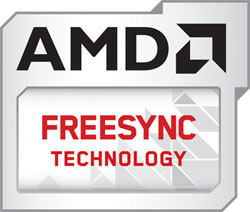
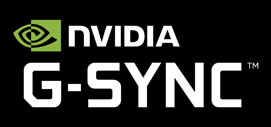
The screen natively supports AMD FreeSync for variable refresh rates between 48 and 144Hz. As listed on AMD's website the screen is not certified under their newer FreeSync 2 scheme, despite it also including LFC support and accepting an HDR input signal (more on the HDR capabilities later). AMD FreeSync Technology is supported with DisplayPort and HDMI connections, allowing the AD27QD to be compatible with AMD Radeon Graphics Cards (and modern NVIDIA cards for G-sync), Xbox X, Xbox One, and other future gaming consoles and devices that support FreeSync and Adaptive-Sync.
During the course of this review the screen was also officially certified under NVIDIA's recent 'G-sync Compatible' scheme, and so the AD27QD will also support G-sync from compatible NVIDIA graphics cards and systems, over DisplayPort only. You might also want to read our newly updated article about Variable Refresh Rates here.

Detailed Response Times
144Hz Refresh Rate, Overdrive = Speed


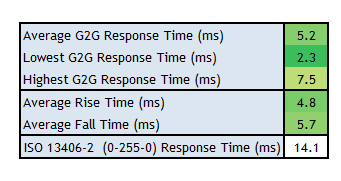
We carried out some further response time measurements at the maximum 144Hz refresh rate supported by the screen and with the overdrive set to the maximum 'speed' setting. Having taken some further measurements at a range of pixel colour transitions, the average G2G response time was more accurately measured now at 5.2ms. Some reached down to a minimum of 2.3ms, but this was where some noticeable overshoot started to creep in. The overshoot at 144Hz in this overdrive mode was moderate overall, and in practice you could see some slight pale halos in motion tests and in practice.
These settings deliver the fastest response time and refresh rate combination, but performance will vary if different refresh rates are used, or if they fluctuate when using FreeSync/G-sync. While on the face of it these numbers seem very good, and in keeping with some other high refresh rate IPS panels we've tested, they don't tell the full story and you need to consider what happens when refresh rate changes. This is particularly important if you're using VRR, as the overshoot at this 'speed' setting does start to become a lot more noticeable from 120Hz and below, and is very distracting at anything at the lower end of the refresh rate range. Running at a fixed 144Hz with the 'speed' setting delivers the best response time performance on this display, but for other refresh rates the 'balance' mode is preferable.
Have a read of the important notes in the following comparison section when comparing the performance of this screen with other popular 27" 1440p high refresh rate IPS models.

Gaming Comparisons
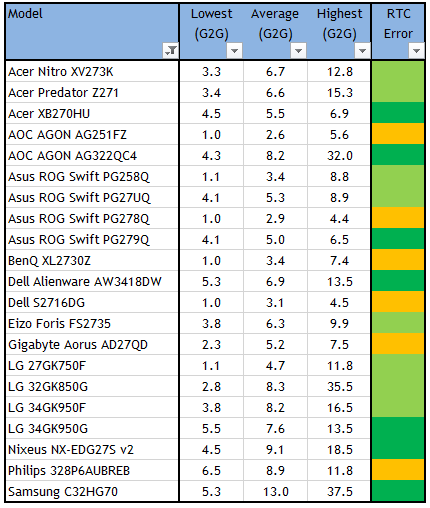
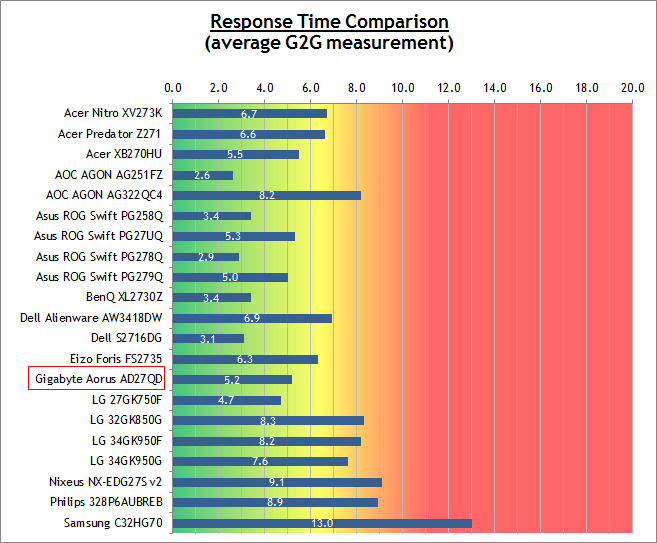
We have provided a comparison of the Aorus AD27QD against many other gaming screens we have reviewed in a similar size range and technology. At optimal settings the Aorus AD27QD was pretty comparable to the other high 144Hz refresh rate 27" 1440p resolution IPS models we've tested such as the still popular Acer Predator XB270HU (5.5ms) and Asus ROG Swift PG279Q (5.0ms). There was a bit more overshoot on the Gigabyte model whereas the others had nothing noticeable, so the new Innolux panel doesn't seem to be quite as fast as the AUO panel used in those other models.
On some of the other popular 27", 1440p, high refresh rate IPS screens like the Asus ROG Swift PG279Q and Acer Predator XB270HU (both hardware G-sync screens), the response time performance was far more stable across the entire refresh rate range though. This seems to be more consistent on G-sync displays from what we've seen to date. The response times on those Asus and Acer models were improved as refresh rate increased, and there was no overshoot noticeable across the range. That seems to be a pattern from hardware G-sync module screens from what we've seen, whereas FreeSync displays like this one show a more variable overdrive performance. Other FreeSync models like the Eizo Foris FS2735 for instance showed the same pattern as the Aorus AD27QD here, where response times reduced a bit as refresh rate went up, and overshoot can be a problem at certain refresh rate ranges. You have to consider different overdrive modes potentially depending on your active refresh rate. It's not as straight forward as those G-sync screens like the Asus and Acer it seems.
Some of the high refresh rate TN Film models were faster, but generally showed moderate levels of overshoot as well (e.g. Asus ROG Swift PG278Q = 2.9ms, and Dell S2716DG = 3.1ms)

Additional
Gaming Features
-
Aspect Ratio Control - the screen has various settings for hardware level aspect ratio control. This includes options for full, aspect and 1:1 which are probably going to be the most useful. There are also some preset sizes and aspect ratios available as you can see above. The screen is 16:9 natively so most external devices are going to be fine without needing scaling anyway.
-
Preset Modes - There are a few different preset modes aimed at gaming that can be customised and used if you want. This includes the 'Aorus', FPS and RTS/RPG preset modes. You can also create and save your own modes if you want which is handy.

-
RGB Fusion LED lighting - Thanks to the free downloadable 'RGB Fusion' app, you’ll be able to create a gaming ambience exclusively to you with its intuitive UI and customizability. LED enthusiasts now have the chance to show off their creativity with the ability to customize multiple zones independently. There are loads of colours and patterns to choose from within the software, or there are 3 defined modes available in the OSD menu as well. The lighting looks nice although being on the back of the screen and stand only, it might not be visible to some users like a downwards lighting system might.
-
Virtual 4K Support - this has been added to accommodate external inputs like games consoles where 4K is supported, but not 1440p. It allows the screen to be seen by devices (including PC's) as accepting a 4K resolution. The screen can then accept a 4K input resolution to then be scaled down to the panels 2560 x 1440 native resolution. This avoids the need to select the lower 1080p resolution from your device and have it scaled up, as you can instead select the 4K input and have it scaled down to hopefully help retain some detail.
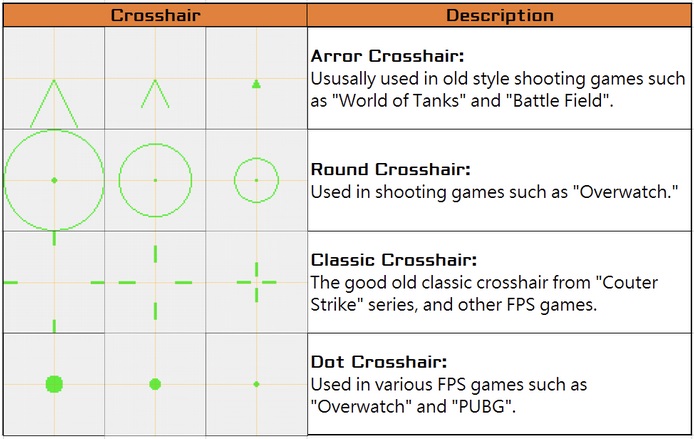
-
Crosshair Pack - this was actually released as an update during the course of our review. It allows gamers to have more choice for their crosshair if they don’t want to draw one themselves. With such a variety of crosshairs, gamers can find the crosshair that suits them the most, which helps them aim faster and improve their reflexes. This pack is available from their downloads page already. “In the crosshair pack, you can find 4 kinds of basic crosshairs used from a variety of game titles. Are you a CS:GO veteran that can’t bring out your best performance because of using a crosshair that you are not used to? Do you love to use round crosshairs from Overwatch but also love to play other shooting games such as APEX Legends which doesn’t have one? The crosshair pack can solve all these problems! AORUS delivered 12 crosshairs in this crosshair pack so carrying your favorite crosshair from one game to another is not a fantasy anymore. You can download the crosshair pack and bring out your best performance in the game by using the crosshair you love most now!”.
After downloading the crosshair pack, you only need to use the OSD sidekick software to import the crosshair you want into your monitor. Click on the crosshair slot that you want to edit then click the edit icon and you’ll open the crosshair edit panel. Click the import button on the panel and choose the crosshair that you want to import and then click save, the crosshair that you chose will be imported into the monitor. The software also has an export function. Click on the export button on the edit panel and you can share your customized crosshair with your friends and create a unique crosshair of your own.
Other gaming features are explained in the graphics below courtesy of Gigabyte's website:

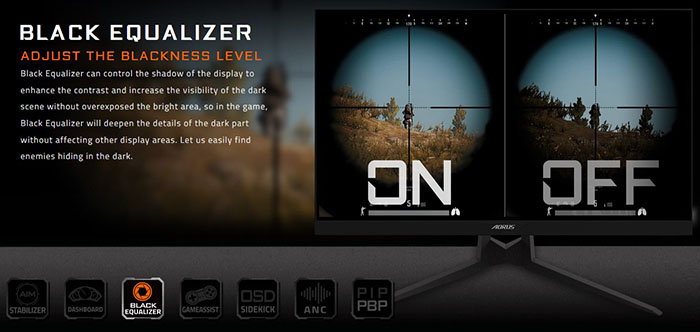
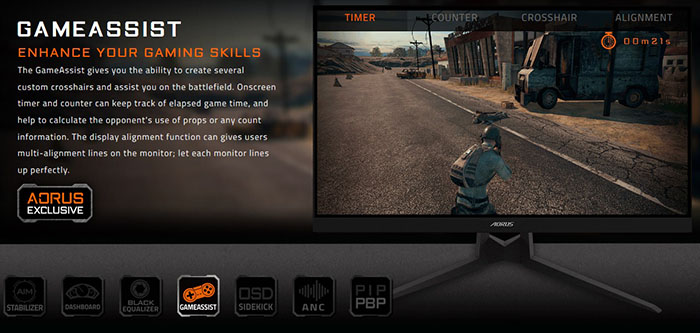
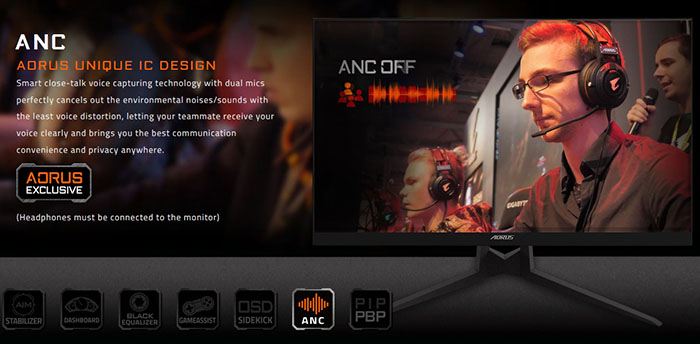


Motion Blur Reduction (Aim Stabilizer)

The strobing blur reduction backlight option is available via the (oddly named and almost missed) 'Aim Stabilizer' setting. This is greyed out and unavailable if you have FreeSync activated in the menu, so you need to disable that if you want to use this feature.
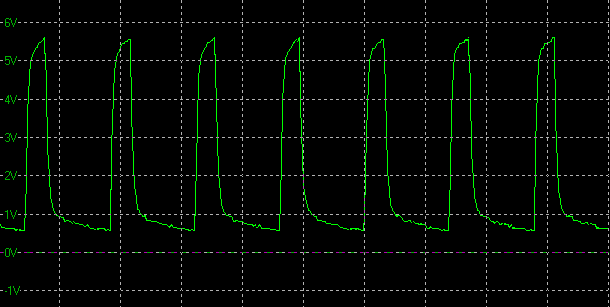
Example strobing at 144Hz, horizontal scale = 5ms
This option is available at refresh rates of 100, 120 and 144Hz only, nothing below that. We measured the on/off strobing using our oscilloscope and confirmed that the strobing is in sync with the refresh rate. So at 144Hz for instance (shown above) the backlight is turned off/on every 6.94ms (144 times per second). At 120Hz it is strobed every 8.33ms, and at 100Hz every 10ms. There is no control in the OSD for anything relating to this mode, so you cannot control the strobe timing or length on this model. You are at the mercy of the provided settings. The overdrive control also becomes locked at the 'speed' setting when Aim Stabilizer is activated.
Max Brightness with Blur Reduction Enabled
|
Refresh Rate |
Luminance |
Black Point |
Contrast Ratio |
|
144Hz |
129.23 |
0.22 |
587:1 |
|
120Hz |
128.52 |
0.22 |
584:1 |
|
100Hz |
126.69 |
0.21 |
603:1 |
When you enable the Aim Stabilizer mode the brightness control becomes locked, and there is no way to manually control it yourself. It doesn't matter what your brightness control was before, the luminance output when you enable Aim Stabilizer is always the same. This is basically the same no matter what the refresh rate is peaking at around 129 cd/m2. The contrast ratio also takes a bit of a hit as you can see, down to around 600:1 in this mode. We felt that this max luminance was quite limited here, especially given the screen is capable of reaching up to 471 d/m2 natively. The reduced contrast ratio was also an issue, implying that some digital white level adjustments are perhaps being made here, which might explain also the limited brightness potential.
Maximum Blur Reduction Brightness - Display Comparison
For ease of reference we have also provided a comparison table below of all the blur reduction enabled displays we've tested, showing their maximum luminance before blur reduction is turned on (normal mode) and their maximum luminance with the feature enabled. This will give you an idea of the maximum brightness you can expect from each model when using their blur reduction feature, if that is important to you. A lot of people want a brighter display for gaming and sometimes the relatively low maximum luminance from blur reduction modes is a limitation.
These comparisons are with the refresh rate as high as is available for the blur reduction feature to function. For most this is at 100 - 144Hz. You can achieve a slightly brighter display if you use the feature at compatible lower refresh rates since the strobes are less frequent, but it's not a significant amount. That can also introduce more visible flicker in some situations.
|
Model |
Refresh Rate |
Max
Normal Luminance |
Max
Luminance Blur Reduction On |
|
Acer XB270HU* |
100Hz* |
327 |
111 |
|
Acer Nitro XV273K |
144Hz |
503 |
195 |
|
Acer Predator Z35 |
120Hz |
359 |
111 |
|
Asus ROG Strix XG35VQ |
100Hz |
376 |
164 |
|
Asus ROG Swift PG258Q |
144Hz |
488 |
275 |
|
Asus ROG Swift PG278Q |
120Hz |
385 |
123 |
|
Asus ROG Swift PG279Q |
120Hz |
331 |
101 |
|
BenQ XL2720Z |
144Hz |
282 |
119 |
|
BenQ XL2730Z |
120Hz |
309 |
191 |
|
Dell S2716DG |
120Hz |
328 |
118 |
|
Eizo FG2421 |
120Hz |
386 |
257 |
|
Eizo FS2735 |
144Hz |
331 |
180 |
|
Gigabyte Aorus AD27QD |
144Hz |
471 |
129 |
|
LG 27GK750F |
240Hz |
452 |
199 |
|
LG 34GK950F |
144Hz |
390 |
235 |
|
LG 34UC79G |
144Hz |
267 |
141 |
|
LG 38UC99 |
75Hz |
308 |
213 |
Note:
Pulse Width setting at max where applicable.
*Note 2: The Acer XB270HU was later updated to include a 120Hz mode, which will
produce a slightly darker maximum luminance
Blur Reduction Tests
Of course the main thing we want to test is what improvements the Blur Reduction mode offers when it comes to motion clarity and gaming. We were pleased with the results we'd seen from LightBoost backlights when we tested them, and also from the natively supported blur reduction feature on other displays including the other popular gaming models we've tested. The following pursuit camera photos give you an indication of observed motion clarity as the human eye would see it at the top, middle and bottom areas of the screen. These were captured at the maximum 144Hz refresh rate.
As with most strobing blur reduction backlights it did help improve eye tracking of moving objects across the screen, making them sharper and easier to follow. That's one of the key benefits of this kind of technology. However, you can see from the below photos that all areas of the screen showed some noticeable strobe cross-talk, where a trailing ghost image follows behind the moving UFO. This is caused by the timing of the strobe. It's not possible to eliminate this across the whole screen, but usually there is a region where it is optimised, often in the central area where most of your attention would be focused during use. On this screen the upper region delivered the clearest image, but it was still not ideal. The middle and lower regions showed much high levels of cross talk as you can see.
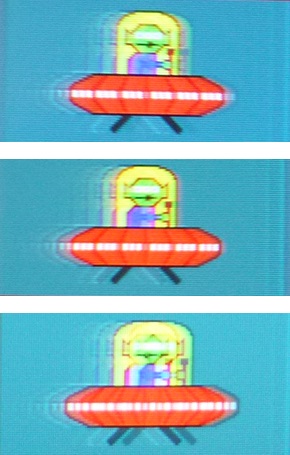
Pursuit camera photos capturing motion clarity at the top, middle and bottom
areas of the screen (144Hz)
Performance Observations and Conclusion
We did observe some slight flickering and fluctuations in the appearance of the screen with this mode enabled. That is hard to spot in dynamic content like gaming, but we felt it was a little more noticeable on desktop than we had experience on other blur reduction backlight implementations. This was even at the maximum 144Hz where the strobing is at its fastest. Obviously you won't want to use this mode for day to day desktop use, but the fact we saw a bit more flickering shows that perhaps it's not as easy on the eyes as other blur reduction backlights we've tested.
Overall we felt the blur reduction backlight missed the mark on this screen. Given Gigabyte are making user-updatable firmwares available on this model, perhaps this is something they can work on for a future update. We felt that considering the screen can achieve a high 471 cd/m2 luminance, the max 129 cd/m2 in this mode was a bit disappointing. That should be higher, and the user should have the ability to change the brightness setting how they like. The hit to the contrast ratio was also not good and probably needs investigating by the manufacturer. The main issue though was the strobe timing, where the cross talk levels were quite high and produced some unwanted trailing images across pretty much the whole screen. If that could be tidied up and the central region motion clarity improved that would be welcome.

Lag
We have written an in depth article about input lag and the various measurement techniques which are used to evaluate this aspect of a display. It's important to first of all understand the different methods available and also what this lag means to you as an end-user.
Input Lag vs. Display Lag vs. Signal Processing
To avoid confusion with different terminology we will refer to this section of our reviews as just "lag" from now on, as there are a few different aspects to consider, and different interpretations of the term "input lag". We will consider the following points here as much as possible. The overall "display lag" is the first, that being the delay between the image being shown on the TFT display and that being shown on a CRT. This is what many people will know as input lag and originally was the measure made to explain why the image is a little behind when using a CRT. The older stopwatch based methods were the common way to measure this in the past, but through advanced studies have been shown to be quite inaccurate. As a result, more advanced tools like SMTT provide a method to measure that delay between a TFT and CRT while removing the inaccuracies of older stopwatch methods.
In reality that lag / delay is caused by a combination of two things - the signal processing delay caused by the TFT electronics / scaler, and the response time of the pixels themselves. Most "input lag" measurements over the years have always been based on the overall display lag (signal processing + response time) and indeed the SMTT tool is based on this visual difference between a CRT and TFT and so measures the overall display lag. In practice the signal processing is the element which gives the feel of lag to the user, and the response time of course can impact blurring, and overall image quality in moving scenes. As people become more aware of lag as a possible issue, we are of course keen to try and understand the split between the two as much as possible to give a complete picture.
The signal processing element within that is quite hard to identify without extremely high end equipment and very complicated methods. In fact the studies by Thomas Thiemann which really kicked this whole thing off were based on equipment worth >100,1000 Euro, requiring extremely high bandwidths and very complicated methods to trigger the correct behaviour and accurately measure the signal processing on its own. Other techniques which are being used since are not conducted by Thomas (he is a freelance writer) or based on this equipment or technique, and may also be subject to other errors or inaccuracies based on our conversations with him since. It's very hard as a result to produce a technique which will measure just the signal processing on its own unfortunately. Many measurement techniques are also not explained and so it is important to try and get a picture from various sources if possible to make an informed judgement about a display overall.
For our tests we will continue to use the SMTT tool to measure the overall "display lag". From there we can use our oscilloscope system to measure the response time across a wide range of grey to grey (G2G) transitions as recorded in our response time tests. Since SMTT will not include the full response time within its measurements, after speaking with Thomas further about the situation we will subtract half of the average G2G response time from the total display lag. This should allow us to give a good estimation of how much of the overall lag is attributable to the signal processing element on its own.
Lag Classification
To help in this section we will also introduce a broader classification system for these results to help categorise each screen as one of the following levels. We will now keep these classifications consistent regardless of the actual refresh rate of the screen being measured:
-
Class 1) Less than 8.33ms - the equivalent to 1 frame lag of a display at 120Hz refresh rate - should be fine for gamers, even at high levels
-
Class 2) A lag of 8.33 - 16.66ms - the equivalent of one to two frames at a 120Hz refresh rate - moderate lag but should be fine for many gamers. Caution advised for serious gaming
-
Class 3) A lag of more than 16.66ms - the equivalent of more than 2 frames at a refresh rate of 120Hz - Some noticeable lag in daily usage, not suitable for high end gaming

For the full reviews of the models compared here and the dates they were written (and when screens were approximately released to the market), please see our full reviews index.
|
|
We have provided a comparison above against other models we have tested to give an indication between screens. The screens tested are split into two measurements which are based on our overall display lag tests (using SMTT) and half the average G2G response time, as measured by the oscilloscope. The response time is split from the overall display lag and shown on the graph as the green bar. From there, the signal processing (red bar) can be provided as a good estimation.
The total lag measured was only 3.30 ms. With around 2.60 ms of that accounted for by pixel response times, we can estimate there is only 0.70 ms of signal processing lag, the actual lag you might feel during gaming and other uses. This was basically nothing and in line with even the fastest gaming screens in the comparison above, including those without a scaler and instead featuring an NVIDIA G-sync hardware module. A great result when it comes to lag from this Gigabyte screen.

Movies and Video
The following summarises the screens performance for videos and movie viewing:
|
Category |
Display Specs / Measurements |
Comments |
|
Size |
27" widescreen |
Fairly typical for a desktop monitor nowadays and smaller than TV's by a lot |
|
Aspect Ratio |
16:9 |
Well suited to most common 16:9 aspect content and input devices |
|
Resolution |
2560 x 1440 |
Can support native 1080p content, but not Ultra HD natively |
|
HDCP |
Yes |
Suitable for encrypted content |
|
Connectivity |
1x DisplayPort 1.2 and 2x HDMI 2.0 |
Useful additional 2x HDMI input for external Blu-ray players or games consoles. |
|
Cables |
DisplayPort only |
Both DisplayPort and HDMI provided |
|
Ergonomics |
Tilt, height. swivel, rotate |
Very good range of adjustments suitable to positioning the screen in a variety of angles for different viewing positions. Tilt is a bit stiff to operate. |
|
Coating |
Light Anti-glare |
Provides clear, non-grainy image and avoids unwanted reflections of full glossy solutions |
|
Brightness range |
63 - 471 cd/m2 |
Good adjustment range offered including a higher peak brightness than many screens (and quite a lot more than advertised 350 cd/m2). Flicker free backlight operation with no PWM |
|
Contrast |
1176:1 after calibration |
Very good IPS contrast ratio which should be fine for most content. Buying an alternative VA technology panel would provide you a higher contrast ratio if you watch a lot of dark content and miss some shadow detail |
|
Preset modes |
Movie |
There is a Movie preset mode which is a bit cooler and slightly less sharp (sharpness set to 4 instead of 5 in the menu) than our calibrated standard mode. It can be easily customised to suit your needs so may be useful |
|
Response times |
5.2ms G2G, moderate overshoot at 144HZ 11.3ms G2G at 60Hz with no overshoot (balance mode) |
Response times are good overall and with moderate levels overshoot in the 'speed' setting. That is only really ideal at maximum 144Hz so you will probably want to switch down to the 'balance' mode for movies and external 60Hz inputs |
|
Viewing angles |
Very good |
Thanks to the IPS panel technology, suitable for viewing from a wide range of positions. IPS glow on dark content could present a problem from some wider angles especially in darker room conditions |
|
Backlight bleed |
No major bleed |
Some slight clouding in the corners and on the right hand edge but nothing major |
|
Audio |
Headphone output |
No integrated speakers on this model, but a headphone jack is provided |
|
Aspect Ratio Controls |
Full, aspect and 1:1 modes along with a variety of preset sizes/aspects |
Good options to account for non-16:9 format inputs if needed although the native aspect of the screen is likely to be suitable for a lot of content |
|
PiP / PbP |
Both supported |
Both available with a wide range of configuration options |
|
HDR support |
No meaningful support |
See below |
HDR Support
The screen is advertised as supporting HDR, although the way it's marketed is slightly odd. The screen is certified on VESA's website as meeting the DisplayHDR 400 standards, which was also mentioned in the original press release for this screen. On Gigabyte's website now they talk about HDR support and it being "VESA DisplayHDR" certified, but don't mention the 400 level. The spec for the screen also only lists a 350 cd/m2 maximum luminance which would imply it can't even meet the lowly HDR400 certification. Our tests have shown that the brightness can reach up to 471 cd/m2 even for SDR content so that element is not a problem at least.
You may have read our article about 'Why Your HDR Monitor is (Probably) Not HDR at All – and Why DisplayHDR 400 Needs to Go', if not then it's well worth a read. As with all the HDR400 screens we've seen to date, the issue with the Aorus AD27QD is that there is no meaningful HDR offered despite the marketing claims and VESA certification. The crux of the issue is that there is no local dimming provided here and therefore no way to improve the dynamic range (contrast ratio) beyond the panel's native ability which is 1176:1 after calibration. The screen can reach a higher brightness than some other screens (471 cd/m2) and does at least feature a wide gamut backlight covering 95% DCI-P3 gamut. There is also 10-bit colour depth support which many other competing screens don't offer. So from a colour point of view it can deliver in the areas popularly considered for an "HDR experience". The issue comes in the screens lack of ability to create any improved dynamic range (contrast) because of the lack of any local dimming.
The screen will accept an HDR input source, and you will benefit from the improved colours and some additional highlight brightness levels, but the underlying contrast ratio of the screen is still limited to the native IPS-panel contrast ratio.

Conclusion
If you would like to help support our continued work please consider making a donation no matter how small or large. Thank you for the continued support.
The Aorus AD27QD is an interesting option in the gaming market, and it's nice to see a new manufacturer emerge with something a bit different to offer. We were impressed by the massive range of features, options and extras provided with this screen which gives it a premium feel and something that enthusiasts are going to enjoy tweaking, updating and optimising over time. Gigabyte have done a good job with the performance too and we were pleasantly surprised by the capabilities of the new Innolux IPS-type panel they've opted to use, in place of the well-established AU Optronics panel used by most of the competition.
Gaming is the primary focus of this screen of course and we felt the screen performed well overall. Some areas were excellent, including the input lag, high refresh rate capability and massive range of extras and options. Along with the native FreeSync support, Gigabyte have even had the screen certified as G-sync Compatible by NVIDIA which should give some further assurances about its VRR capabilities. Response times were on the whole pretty good, and behaved similarly to many other FreeSync screens. They were particularly good at maximum refresh rate, although perhaps being pushed a little too hard at the cost of a bit of overshoot. They were a bit more variable for lower settings and in VRR situations. That's one area where we've seen better stability and performance from hardware G-sync module screens, with many FreeSync models struggling in the same way as this model. That's not to say that performance isn't good at lower refresh rates and with VRR, it's just not as fast as it maybe could be. One area which wasn't so good was the blur reduction mode, which had too much strobe cross talk, poor peak luminance, reduced contrast ratio and lack of much user control. Perhaps it can be improved for a future firmware release, but right now we didn't find it very useful.
The IPS-type panel provided typical all round solid performance with wide viewing angles and good colour rendering. The use of a wide gamut backlight separates this from most other gaming screens at the moment and will be welcome for gaming and multimedia by most people we're sure. There is an sRGB emulation mode options offered which is useable, but a bit inflexible in terms of user control sadly. Not perfect, but something. Default setup was good and there was a strong contrast ratio for an IPS panel. We won't talk too much more about the HDR capabilities, or lack of, but that is common on most screens of this kind of range anyway.
The screen is available at the time of writing (dated at the top of the page) from Amazon (affiliate link) and is normally a fair bit cheaper than popular competing models like the Acer Predator XB271HU and Asus ROG Swift PG279Q. That makes it a very interesting option we think, especially if you want a FreeSync screen or one that won't necessarily lock you in to NVIDIA longer term. There's lots of nice extras and some solid performance. More like this please in the future Gigabyte!
|
Pros |
Cons |
|
Good overall gaming with high refresh rate, decent VRR and very low lag |
Blur Reduction mode doesn't work very well |
|
Massive range of options, features and extras and some nice software available to support usage |
sRGB emulation mode is useable and works well, but is inflexible in control |
|
Good all round performance from IPS-type panel |
Response time performance varies across refresh rate range making it a little tricky sometimes |
|
Check Pricing and Buy - Affiliate Links |
|
TFTCentral is a participant in the Amazon Services LLC Associates Programme, an affiliate advertising programme designed to provide a means for sites to earn advertising fees by advertising and linking to Amazon.com, Amazon.co.uk, Amazon.de, Amazon.ca and other Amazon stores worldwide. We also participate in a similar scheme for Overclockers.co.uk. |
|
TFT Central Awards Explained We have two award classifications as part of our reviews. There's the top 'Recommended' award, where a monitor is excellent and highly recommended by us. There is also an 'Approved' award for a very good screen which may not be perfect, but is still a very good display. These awards won't be given out every time, but look out for the logo at the bottom of the conclusion. A list of monitors which have won our awards is available here. |




